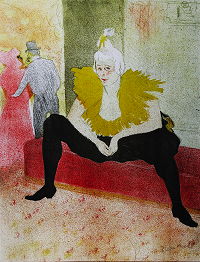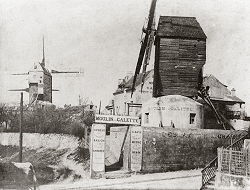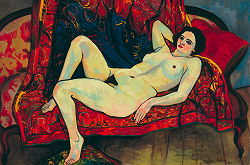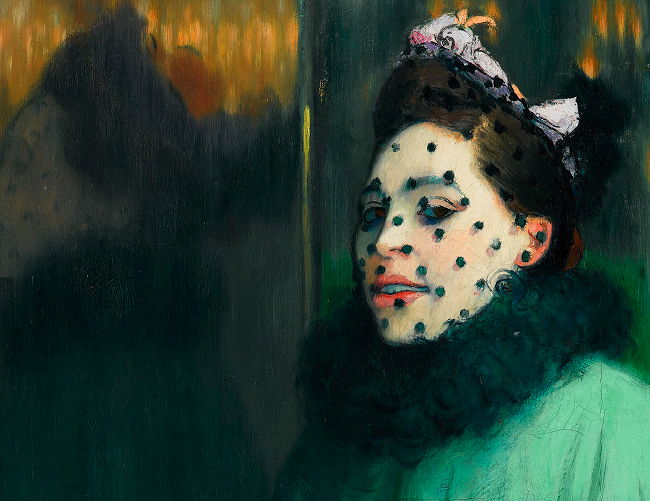Not without reason, a contemporary critic in the 1890s wrote about Montmartre in Paris: “The quarter resembles a huge studio.” Important artists such as Edgar Degas, Pablo Picasso, Henri de Toulouse-Lautrec, or Vincent van Gogh lived and worked there. With a previously unsuspected realism, they produced memorable paintings that mercilessly revealed the underbelly of the dazzling Belle Époque. With these works, which remain unique even today, they crucially influenced the history of art in the late nineteenth and the early twentieth century. The Schirn Kunsthalle Frankfurt presents more than 200 works on the quarter of Montmartre with its stories and protagonists.
 Henri de Toulouse-Lautrec, La Clownesse assise, Mademoiselle Ch-U-Ka-O, 1896. Lithography, 51,5 x 39,4 cm © Collection J.P. Gimbergues
Various phenomena are explored in different thematic sections: “Montmartre as a Village – A View of a different Paris” confronts the visitor with atmospheric views of the neighborhood’s topography. The exhibition then highlights the “Cafés, Absinthe Drinkers, and Varietés” and the representation of “Models, Dancers, and Prostitutes.” A further section deals with “The Fantasy Land of the Circus.” “The Montmartre as an Area for Outsiders and Social Change” introduces the visitor to the inhabitants of the district, its labourers, beggars, clochards, and washerwomen, but also to the people who participated in demonstrations in these politically and socially agitating days. While “The Network of Artists and Art Dealers” sheds light on the exchange between artists and the flourishing art market in the quarter, the last section is dedicated to “The Poster as a New Art Form” and magazine illustrations. The presentation spans from around 1885 to the beginning of the First World War, when most artists moved to the southern Montparnasse area.
 Historical photograph Montmartre, Entrance of Le Moulin de la Galette, 1900. Collection Société d'Histoire Le Vieux Montmartre
Montmartre, named after the hill on which it is located has belonged to Paris since 1860. The quarter offers a contrasting alternative to chic Paris with its wide boulevards and long avenues radically systematized by the urban planner Georges-Eugène Haussmann. With its abandoned quarries, old mills, gardens, vacant lots, and the slum known as the “Maquis”, the quarter has preserved an almost rural character. Montmartre provided fertile soil for painters as well as poets, writers, and composers, such as Paul Verlaine, Jacques Offenbach, and Erik Satie. They all found cheap accommodations there, living together with actors, washerwomen, and seamstresses in the Bateau-Lavoir, probably the most famous studio building. The poverty was frequently not only exposed in the artists’ pictures but constituted a crucial element of the way they stylized themselves as bohemians, an attitude that went hand in hand with their desire for individual and artistic freedom. The artists chose themes from their everyday life and brought unusual perspectives to their painting through their personal views.
 Suzanne Valadon, Nu au canapé rouge, 1920. Oil on canvas 80 x 120 cm © Musée du Petit Palais, Genève
Montmartre was considered a microcosm for artistic self-perception that first found literary expression in Henry Murger’s novel Scènes de la vie de Bohème (1847–1849). The neighborhood soon attracted numerous artists who deliberately chose a bohemian life in impoverished circumstances on the margins of society – even though they often came from wealthy homes. Their new identity as voluntarily involuntary outsiders was mirrored especially realistically and impressively in their art. The exhibition assembles outstanding paintings and works on paper, historical photographs, posters, and graphic works from German and foreign museums and private collections such as the Musée d’Orsay in Paris, the Tate Gallery in London, the Van Gogh Museum in Amsterdam, the Kunsthaus Zurich, the Museu Picasso in Barcelona, and the Museum of Modern Art in New York. Works by 26 artists like Pierre Bonnard, Ramon Casas, Edgar Degas, Kees van Dongen, Vincent van Gogh, Max Jacob, Marie Laurencin, Pablo Picasso, Henri de Toulouse-Lautrec, Suzanne Valadon, and other less known, yet equally fascinating artists convey a vivid impression of the historically unique atmosphere of Montmartre around 1900.
PUBLICATION:
• Esprit Montmartre. Bohemian Life in Paris around 1900 / Die Boheme in Paris um 1900. Edited by Ingrid Pfeiffer and Max Hollein. With a foreword by Max Hollein and essays by Nienke Bakker, Markus A. Castor, Phillip D. Cate, Danièle Devynck, Anita Hopmans, Peter Kropmanns, Chloë Langlais, Vinyet Panyella, Robert McD. Parker, and Ingrid Pfeiffer, as well as biographies of the artists and a historical map with addresses of studios, places of entertainment, galleries and so on by Michael Raeburn. German and English editions, each of 320 pages with ca. 320 color illustrations, 24 x 29 cm, hard cover; designed by Kühle und Mozer, Cologne; Hirmer Verlag, Munich, €30 (Schirn), €49,90 (trade edition).
To see more illustrations, click on VERSION FRANCAISE at the top of this page
|











